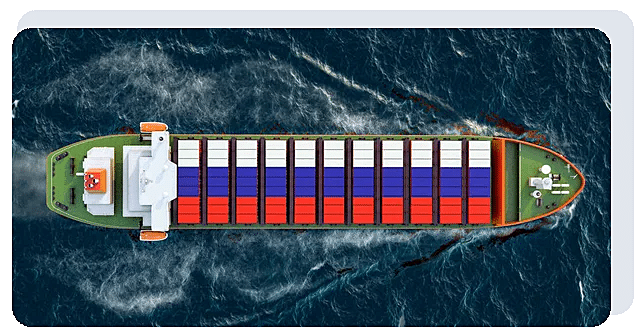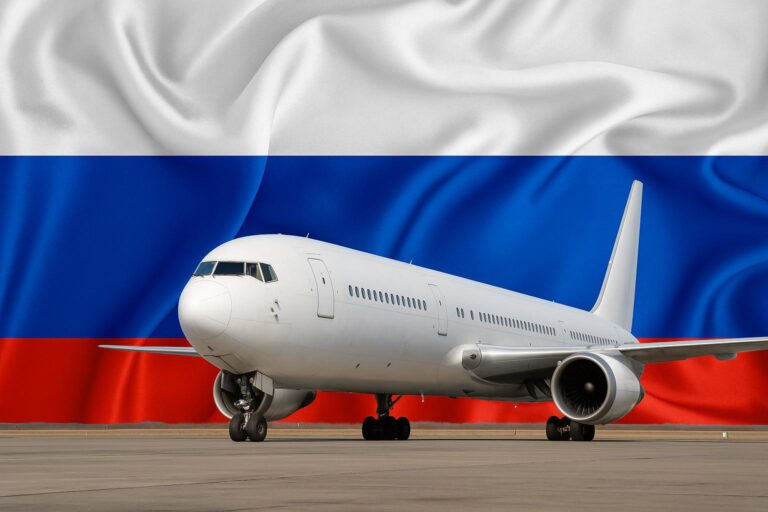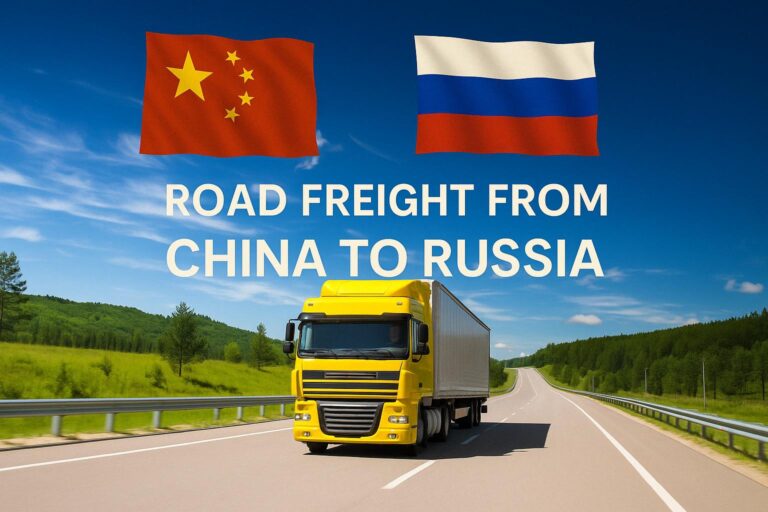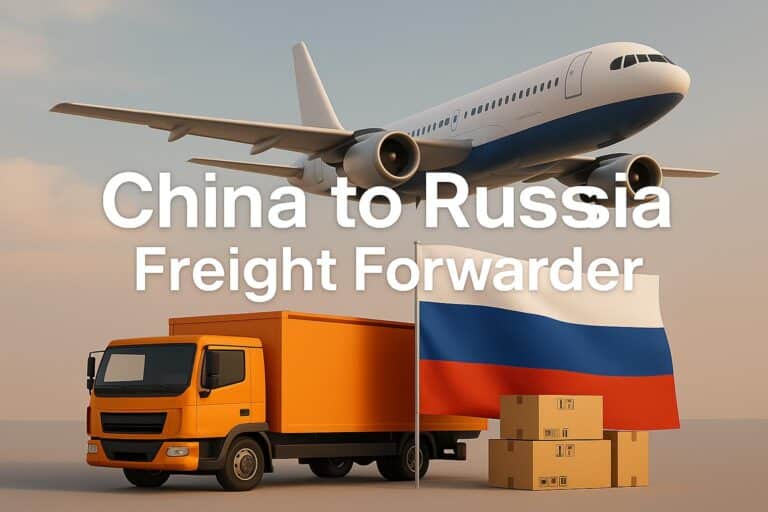Shipping from China to Russia
Your One-Stop Logistics Provider for Air, Sea, Rail & Road Freight
Shipping from China to Russia
Shipping from China to Russia plays a critical role in the growing bilateral trade between the two countries. As international logistics continue to evolve, businesses are increasingly seeking cost-effective, reliable, and flexible shipping methods to meet their diverse needs. Whether you’re transporting goods to Moscow via rail freight, using air freight for urgent deliveries, or opting for sea freight to Russian ports like Saint Petersburg, understanding the full shipping process is essential.
This comprehensive guide explores the major shipping methods from China to Russia—including air, sea, rail, and road transport—while breaking down the shipping costs, transit times, customs clearance procedures, and how to choose the right freight forwarders. From bulk shipments to door-to-door services, we’ll help you navigate the best shipping solutions to reduce shipping costs and ensure a seamless shipping experience across borders.

Table of Contents
Shipping from China to Russia | Sea, Air, and Rail Freight Transit Time & Rates
China and Russia’s economic and trade partnership has flourished over the past decade, with China holding its position as Russia’s top trading partner. In 2023, the trade volume between the two nations reached an impressive US$150 billion, highlighting the robust trade relationship. During this period, China’s exports to Russia accounted for US$60 billion, reflecting a strong and consistent growth in trade.
China’s export portfolio to Russia includes machinery, electronics, textiles, and consumer goods, all supported by efficient logistics networks. This article explores the three primary modes of transportation—sea, air, and rail—and provides a comprehensive guide to shipping from China to Russia.

Air Freight from China to Russia
Air freight is the fastest and most efficient method for shipping goods from China to Russia, especially when dealing with urgent deliveries or time-sensitive shipments. Major international airports such as Beijing Capital (PEK), Shanghai Pudong (PVG), and Guangzhou Baiyun (CAN) offer direct and indirect flights to Moscow (SVO) and other key Russian cities.
When to Choose Air Freight?
Air freight shipping service is ideal for high-value or lightweight goods, electronics, medical supplies, and commercial samples. It is also the preferred option for businesses looking to shorten lead times and meet tight production schedules.
Transit Time and Air Freight Costs
Shipping by air from China to Russia typically takes 1 to 5 days, depending on the route and service level (direct flight vs transshipment). However, this speed comes at a price—air freight costs are significantly higher than sea or rail transport. Costs are usually calculated based on chargeable weight, which considers both gross and volumetric weight using the air freight formula:
Chargeable Weight (kg) = Length × Width × Height (cm) / 6000
For example:
100 kg air shipment: around $3.00–$4.50/kg
300 kg shipment: discounted rates between $2.50–$4.00/kg
Air Freight Documentation
Key documents required for international air transport include:
Air Waybill (AWB)
Commercial invoice
Packing list
Export declaration (if needed)
Working with experienced freight forwarders helps simplify the customs clearance process on both the Chinese and Russian sides.
Pros and Cons of Air Freight
Advantages | Disadvantages |
|---|---|
Fastest transit time (1–5 days) | Higher costs compared to sea/rail |
Secure handling and less damage risk | Limited space for bulk shipments |
Suitable for urgent or small cargo | Subject to airline schedules/weather |
If you’re aiming for speed and reliability, air freight from China to Russia is a smart shipping method—particularly when customer satisfaction and tight timelines are key business drivers.

Sea Freight to Russian Ports
Sea freight is one of the most cost-effective shipping methods from China to Russia, particularly for large shipments and goods that are not time sensitive. It is the preferred option for businesses moving full container load (FCL) or less than container load (LCL) cargo, offering significant savings on shipping costs compared to air freight.
Major Sea Ports and Routes
The primary Russian port for sea freight from China is Saint Petersburg, which serves as a critical entry point for goods destined for central and western Russia, including Moscow. Other ports such as Vladivostok and Novorossiysk are also utilized depending on the shipping route and cargo destination.
Popular routes include:
Shanghai / Ningbo / Shenzhen → Saint Petersburg (via Suez Canal or Arctic passage)
Qingdao / Dalian → Vladivostok (suitable for Far East Russia)
Transit time varies between 30–45 days, depending on the origin port, transshipment hub, and chosen carrier.
Types of Container Load Options
FCL (Full Container Load): Best for bulk shipments or when filling an entire container (20ft or 40ft).
LCL (Less than Container Load): Ideal for smaller shipments that can share container space with other cargo—this reduces costs for lower cargo volumes.
Typical commodities shipped via sea freight include:
Machinery and auto parts
Furniture and construction materials
Clothing and textiles
Electronics in bulk
Sea Freight Costs and Factors
Sea freight shipping costs vary depending on:
Container type (20ft / 40ft)
Shipping route and port charges
Fuel prices and seasonal fluctuations
Container space availability
Estimated cost examples (as of 2025):
Route | 20ft Container | 40ft Container | Transit Time |
|---|---|---|---|
Shanghai – St. Petersburg | $3,000 | $4,500 | 35–45 days |
Shenzhen – Vladivostok | $600 | $800 | 30–35 days |
Pros and Cons of Sea Freight
Advantages | Disadvantages |
|---|---|
Most cost-effective for large volume | Slower transit time (30+ days) |
Suitable for bulk shipments | Sensitive to port congestion & delays |
Availability of FCL & LCL options | Requires longer planning and lead time |
If you’re shipping goods in large volumes or looking to reduce shipping costs, sea transport to Russian ports remains the go-to solution—especially when paired with efficient customs clearance services and inland transport.
Rail Freight via China-Europe Express
Rail freight between China and Russia has become a popular option for shippers seeking a balance between speed and cost. Thanks to the China-Europe Railway Express, goods can be delivered to Russian cities like Moscow, Ekaterinburg, and Kazan in as little as 12–20 days, making it significantly faster than sea freight while remaining more affordable than air transport.
Advantages of Rail Freight
Rail freight is particularly suitable for:
Medium-to-large shipments (1–20 CBM)
E-commerce goods and general merchandise
Machinery, electronics, and consumer products
It offers a cost effective shipping method for businesses that need timely delivery but want to avoid the high air freight costs.
Key Rail Routes from China to Russia
Several well-established rail corridors connect Chinese cities to Russia:
Origin (China) | Destination (Russia) | Transit Time |
|---|---|---|
Chongqing / Xi’an | Moscow | 14–18 days |
Yiwu / Zhengzhou | Ekaterinburg | 15–20 days |
Suzhou / Wuhan | Kazan | 16–22 days |
These trains typically travel through Kazakhstan or Mongolia before entering Russia, depending on the shipping route and customs arrangements.
Shipping Containers and Cargo Volume
Rail freight supports both FCL and LCL services:
FCL rail containers are best for businesses with large cargo volume looking for dedicated space.
LCL rail shipments allow you to combine smaller shipments with others, optimizing container usage and cost.
The flexibility of rail makes it a valuable option for time-sensitive shipments without the higher costs associated with air freight.
Cost and Documentation
Rail freight rates vary depending on container size, destination, and service provider. Generally, expect to pay:
$60–$100/m³ for LCL shipments
$3,500–$5,000 for full 40ft containers
Required documents include:
Commercial invoice
Packing list
Customs declaration
Rail transport contract
Rail freight also offers alternative routes during peak seasons or when sea lanes are congested—helping ensure your supply chain remains stable and responsive.

Road Freight and Truck Delivery from China to Russia
Road freight is a flexible and increasingly utilized shipping method for transporting goods from China to Russia, especially for regional distribution and inland cities beyond Moscow. Using dedicated truck transport or consolidated loads, road freight allows for direct delivery without relying on seaports or rail hubs, reducing transit time for certain destinations.
Main Road Transport Routes
Truck routes from China to Russia typically pass through:
Manzhouli → Zabaikalsk (Trans-Baikal route)
Erenhot → Ulaanbaatar → Russia (via Mongolia)
Khorgos → Almaty → Russia (via Kazakhstan)
These routes connect Chinese manufacturing hubs (such as Shenzhen, Yiwu, Guangzhou, and Chengdu) directly to Russian regions like:
Moscow
Novosibirsk
Saint Petersburg
Kazan
Transit time ranges from 10–20 days, depending on the route, border clearance, and delivery region.
Road Freight Options
FTL (Full Truck Load): Ideal for businesses shipping high cargo volumes or oversized goods.
LTL (Less Than Truck Load): Suitable for small to mid-sized shipments, sharing truck space with others to reduce shipping costs.
Road freight is particularly advantageous for:
Fragile goods needing fewer handlings
Urgent cargo where rail or sea delays are unacceptable
Shipments requiring door shipping and flexible delivery schedules
Documentation and Customs
Truck shipments require:
Commercial invoice
Packing list
Driver’s manifest
Transit permits and border clearance documents
A professional freight forwarder can ensure a smooth customs clearance process, minimizing wait times at land borders and facilitating a seamless shipping experience.
Pros and Considerations
Advantages | Limitations |
|---|---|
Fast and direct delivery across borders | Higher cost than rail or sea for large cargo |
Door-to-door capability | Sensitive to border delays and road conditions |
Ideal for short to medium-range routes | Limited availability during peak seasons |
Road transport offers a smart middle-ground for companies needing efficient service without relying solely on ports or airports. It supports shipping goods with precision and flexibility across vast regions of Russia.

Door to Door Shipping Services from China to Russia
Door to door shipping is one of the most convenient and hassle-free logistics solutions for businesses importing goods from China to Russia. This comprehensive service manages the entire shipping process—from supplier pickup in China to final delivery at the customer’s doorstep in Russia—eliminating the need for buyers to coordinate with multiple service providers.
What’s Included in Door to Door Services?
A complete door to door service typically covers:
Domestic pickup from the Chinese supplier
Export customs clearance and documentation in China
International shipping (via air, sea, rail, or truck)
Russian customs clearance
Final mile delivery to the recipient’s address in Russia
Whether you’re shipping commercial cargo, e-commerce parcels, or machinery, door-to-door logistics can be customized to meet the needs of both small and large businesses.
Courier Service and Express Delivery Options
For small packages or e-commerce orders, express courier service options such as EMS, SF Express, and specialized e-express shipping solutions are available. These are particularly useful for parcels under 30 kg and often provide tracking and direct delivery within 5–12 days.
For larger shipments, freight forwarders may arrange combined transport methods, such as rail + truck or sea + inland delivery, to optimize cost and speed.
Benefits of Door to Door Logistics
Advantages | Considerations |
|---|---|
End-to-end logistics in one package | Slightly higher total cost |
Reduces paperwork and coordination | Requires a reliable freight partner |
Ensures smooth customs clearance | Limited control over individual steps |
Great for small businesses and FBA | May not be ideal for extremely large cargo |
Door to door shipping is ideal for importers who want to reduce shipping costs related to delays, miscommunication, or paperwork errors. It offers a seamless shipping experience from China to anywhere in Russia—whether it’s central Moscow or more remote regions.
Customs Clearance and Import Duties in Russia
Successfully importing goods into Russia from China requires a clear understanding of the customs clearance process and the applicable import duties. Russian customs regulations can be complex, and improper documentation or misclassification may lead to costly delays, penalties, or cargo seizure.
Customs Clearance Process
Once your shipment arrives at a Russian port, airport, or land border, it must go through russian customs before being released for domestic distribution. The customs clearance involves several steps:
Customs declaration submission
HS code classification of goods
Payment of applicable customs duties and VAT
Inspection (if selected by customs)
Cargo release
Required Documentation
To ensure smooth processing, the following documents are typically required:
Commercial invoice detailing product description and value
Packing list
Bill of lading, air waybill, or rail consignment note
Import license (for restricted goods)
Certificates of conformity (GOST or EAC when applicable)
Customs declaration form
Working with a freight forwarder that provides customs clearance services can help avoid delays and ensure regulatory compliance.
Russian Import Duties and Taxes
Import duties in Russia are generally calculated as a percentage of the customs value, which includes:
Product cost
International shipping cost
Insurance (if applicable)
Standard duties range from 0% to 20%, depending on the HS code and product category. In addition to duties, importers must pay Value Added Tax (VAT), typically 20%.
For certain goods like electronics, batteries, and cosmetics, additional compliance documentation may be required to pass russian customs inspections.
How to Avoid Delays and Overcharges
Ensure accurate product classification
Maintain clear and complete documentation
Work with reliable freight forwarders familiar with Russian import procedures
Consider integrated services (freight + customs handling) for added convenience
A smooth customs clearance is crucial to avoid disruptions in the supply chain and achieve timely deliveries to your Russian customers. Professional guidance can significantly affect your overall cost efficiency and regulatory compliance.
Shipping Costs and Time Estimates from China to Russia
Understanding the total shipping costs and estimated delivery times is crucial for businesses planning to import goods from China to Russia. The cost effectiveness of each shipping method—whether it’s air freight, sea freight, rail freight, or road transport—varies depending on cargo volume, destination, speed requirements, and seasonality.
Shipping Cost Breakdown by Method (2025 Estimate)
Shipping Method | Best For | Estimated Cost | Transit Time |
|---|---|---|---|
Air Freight | Urgent or small cargo | $3.00–$4.50/kg (100 kg) | 1–5 days |
Sea Freight (FCL) | Large or heavy goods | $2,250 (20ft) / $3,900 (40ft) | 30–45 days |
Sea Freight (LCL) | Small to mid-size shipments | $60–$100/m³ | 35–50 days |
Rail Freight | Balanced cost and speed | $60–$100/m³ or $3,500–$6,000 (40ft) | 12–20 days |
Road Freight | Door delivery & flexibility | $2,000–$4,000 per truckload | 10–20 days |
Note: Prices vary depending on fuel prices, seasonal demand, container space, and chosen route.
Factors Affecting Shipping Rates
Several variables influence shipping rates, including:
Container load: FCL vs less than container load
Cargo volume and weight
Delivery urgency (e.g., time sensitive shipments)
Fuel prices and surcharges
Shipping route and distance from port
For smaller shipments, using LCL sea freight or shared rail containers can help reduce shipping costs. For large and bulk shipments, booking a full container load or full truck offers better per-unit pricing.
Choosing the Right Shipping Method
Scenario | Recommended Shipping Method |
|---|---|
Small, urgent e-commerce parcels | Air freight or express delivery |
Large commercial goods to central Russia | Rail freight or sea + truck |
Fragile goods needing minimal handling | Road freight or air transport |
Budget-sensitive shipping with flexibility | LCL sea freight |
Choosing the right combination of transit time and budget helps businesses strike the optimal logistics balance. When in doubt, consult with professional freight forwarders to tailor the best route and shipping services for your business.
How to Choose a Freight Forwarder to Russia
Selecting a trustworthy freight forwarder is critical for successful international shipping from China to Russia. An experienced forwarder ensures seamless coordination across borders, optimizes costs, and helps navigate the complexities of customs clearance, multimodal transport, and local delivery.
Why You Need a Freight Forwarder to Russia
Freight forwarders to Russia act as your logistics partner, handling everything from export procedures in China to delivery services in Moscow, Saint Petersburg, or other destinations. Their services include:
Coordinating air, sea, rail, or road freight
Booking shipping containers
Managing documentation and customs clearance
Offering door to door shipping solutions
Providing real-time tracking and status updates
A reliable freight forwarder can reduce delays, avoid penalties, and provide cost effective shipping options.
Key Qualities of a Reliable Freight Forwarder
When evaluating a potential partner for freight forwarding to Russia, consider the following:
Criteria | What to Look For |
|---|---|
Experience in China–Russia trade | Proven success handling routes to major Russian cities and ports |
Customs expertise | Knowledge of Russian import regulations, duties, and certifications |
Multimodal capabilities | Ability to offer air, rail, sea, and road transport combinations |
Strong carrier network | Access to competitive shipping rates and space availability |
End-to-end support | Comprehensive services including customs, transport, and delivery |
Clear communication | Dedicated team with multilingual support and fast response times |
Benefits of Working with the Right Forwarder
Reduce shipping costs through route optimization
Ensure minimal risk of cargo detention or misrouting
Enjoy a seamless shipping experience with centralized coordination
Improve customer satisfaction with timely and safe delivery
If your shipment requires speed, reliability, and flexibility, partner with a forwarder who understands both global markets and local Russian logistics. This will ensure your cargo reaches its destination efficiently and cost-effectively.

Conclusion: Shipping from China to Russia Made Simple
Whether you’re moving bulk cargo or small parcels, shipping goods from China to Russia involves selecting the right shipping method, managing documentation, and working with experienced freight forwarders. From air freight for fast delivery to sea freight for heavy container loads, and rail or road transport for inland flexibility, each route offers a unique balance of cost, time, and convenience.
By understanding your product type, cargo volume, urgency, and budget, you can develop a cost effective shipping strategy tailored to the needs of the Russian Federation. With the right logistics partner, your shipments can flow smoothly through every stage of the shipping process—from factory in China to the end customer in Russia.
Frequently Asked Questions (FAQs)
What is the cheapest way to ship from China to Russia?
LCL sea freight and rail freight are often the most cost effective options for large or non-urgent shipments.
How long does shipping from China to Russia take?
Air freight: 1–5 days
Rail freight: 12–20 days
Sea freight: 30–45 days
Road transport: 10–20 days
Do I need to pay import taxes in Russia?
Yes. Most goods are subject to customs duties (0–20%) and VAT (usually 20%) based on customs value.
Can I ship directly to a customer’s address in Russia?
Yes. Door to door shipping is available via air, rail, or truck, especially when arranged with a freight forwarder offering delivery services.
Is air freight from China on an airplane to Russia reliable?
Yes. Major carriers offer reliable air freight shipping services with tracking and fast customs clearance in cities like Moscow.
What ports and cities in Russia receive sea or rail freight?
Main shipping routes include Saint Petersburg (port), Vladivostok (port), and Moscow (rail terminal).
Can I combine smaller shipments with others?
Yes. You can share container space using LCL sea freight or LCL rail services, which helps reduce costs.
What is the best transport method for urgent deliveries?
Air freight is best for time-sensitive shipments, while express trucking is also effective for regional delivery.
Work with Tonlexing: Your Trusted Freight Forwarder from China to Russia
At Tonlexing, we specialize in providing reliable and cost-effective shipping services from China to Russia. With years of experience in international logistics, we offer tailored solutions for air freight, sea freight, rail transport, and road delivery—ensuring your cargo reaches its destination on time and within budget.
Why Choose Tonlexing?
End-to-end door to door shipping solutions
Expert assistance with customs clearance and documentation
Competitive shipping rates with guaranteed space
Real-time tracking and dedicated customer support
Full support for bulk shipments, small parcels, and e-commerce cargo
Whether you’re shipping to Moscow, Saint Petersburg, or any point across the Russian Federation, Tonlexing is your trusted partner for seamless, secure, and cost effective logistics.
Get a Quote Today – Let us simplify your China to Russia shipping process with efficient service and full transparency.
Contact Us or reach out via WhatsApp to discuss your shipment needs.
GET A QUOTE
REQUEST A QUOTE
INDUSTRY SOLUTIONS
NEWS & CASE
COMPANY LINK
QUICK CONTACT
(+86) 13424221829
No. 8-10, 7th Floor, Foreign Trade Light Industry Building, No. 1002, Aiguo Road, Luohu District, Shenzhen


